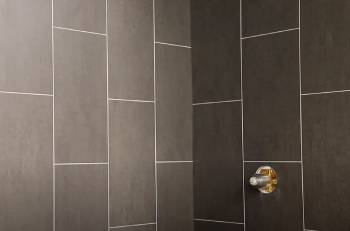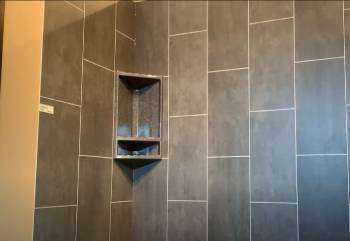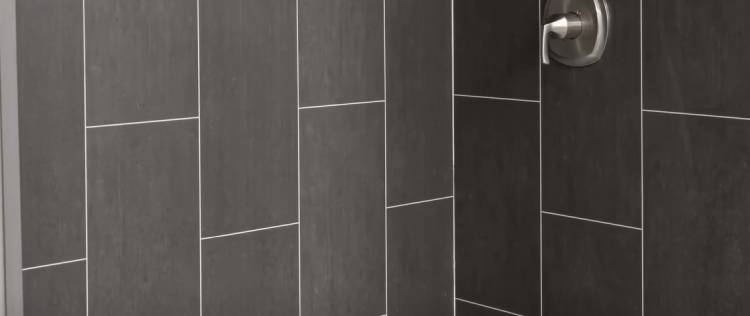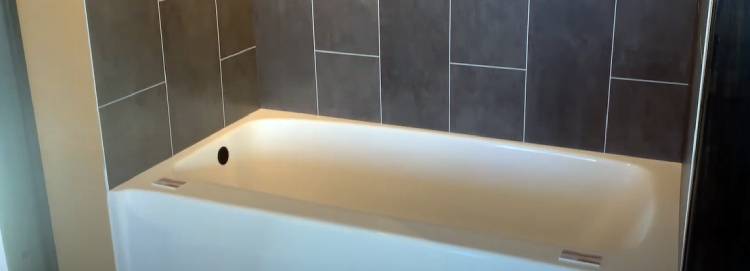When considering a bathroom remodel, one of the easiest ways to transform the look and feel of your space is by upgrading the shower.
If you’re like me, you’ve probably scoured the market for options that are not only affordable but also promise a stylish finish without the hassle of mortar and grout.
Enter the Jetcoat Shower Wall System—a product designed to give you the look of tile without the headache of installation.
At first glance, this sounds like a dream solution for those of us who want a DIY-friendly project. But does it live up to the hype?
As someone who’s always on the lookout for convenient solutions, I decided to dig into the reviews and share my experience with the Jetcoat Shower Wall System.
My First Impression of The Jetcoat Shower Wall System
When the Jetcoat Shower Wall System arrived at my doorstep, I had high hopes. From the product description, it seemed like the perfect solution for someone like me who wants to give their bathroom a fresh look without dealing with the mess and time-consuming process of tiling.
The idea of a grout-free finish was particularly appealing, and the promise that it could be installed in just a few hours made it sound like a dream come true. I mean, who wouldn’t want a quick and affordable bathroom makeover, right?
- The Packaging and Unboxing

As I unboxed the Jetcoat system, the first thing I noticed was how lightweight the panels were.
This gave me some hope, as handling large, heavy panels during installation can be a real hassle, especially if you’re working alone.
However, there was something about the lightweight feel that also made me slightly nervous—could these panels really be durable enough for a high-use area like a shower?
My gut feeling was already starting to stir up some doubts.
Everything was neatly packaged, and at first glance, the panels looked just as advertised—sleek, with a faux tile finish that was quite convincing. However, as I started pulling the pieces out, I couldn’t help but notice that some of the edges seemed fragile, almost too thin for comfort.
I’ve worked with DIY materials before, and these panels seemed to be on the delicate side, which didn’t exactly inspire confidence.
- Installation Challenges Begin
With the panels unboxed and ready, I followed the instructions carefully, hoping for the quick and easy installation that Jetcoat boasted about. The process seemed straightforward: measure, cut, and adhere the panels to the wall.
However, once I got to work, things weren’t as seamless as I had imagined.
The first red flag popped up when I started handling the panels more extensively. They felt flimsy—flimsier than I expected—and I found myself worrying about damaging them with each move.
It turns out that my worries weren’t unfounded. As I tried to maneuver one of the side panels into place, I heard a small crack, and sure enough, a section near the faux grout line had snapped. This was beyond frustrating, especially considering I was handling the panels with care.
At that moment, it became clear to me that the Jetcoat system might not be as sturdy as I had hoped. I was already imagining the possibility of ordering replacement panels, which would mean more delays and additional costs—a headache I was not prepared for.
- Adhesion Issues

Moving past the fragility of the panels, I continued with the installation, following the instructions to use the provided double-sided construction tape.
This was another area where the product began to disappoint.
While the adhesive was supposed to make the process easier, it didn’t seem strong enough to hold the panels securely.
After placing the first panel, I noticed that when even the slightest pressure was applied, the seams began to shift and open slightly. This was particularly concerning, as a shower wall needs to be sealed tight to prevent moisture from seeping behind the panels.
It was a disheartening realization. If the adhesive couldn’t hold the panels in place during installation, how would it fare over time in a humid bathroom environment?
I wasn’t about to take any chances, so I ended up using additional adhesive just to make sure everything stayed in place, which added more time and effort to a project that was supposed to be quick and simple.
- Aesthetics: Looks Can Be Deceiving
Despite the growing list of issues, I have to admit that the Jetcoat Shower Wall System does have one thing going for it: appearance. Once I finally got the panels up (after much trial and error), I stepped back to admire how the faux tile and grout lines looked.
To the untrained eye, it could easily pass for real tile, and the sleek, clean lines did give my bathroom a more modern feel.
However, as they say, looks can be deceiving. While the walls may have looked good at first glance, knowing how fragile and poorly adhered they were took away from the satisfaction of the final result.
It was hard to feel good about the new look when I couldn’t shake the feeling that the walls were one accidental nudge away from breaking or peeling away.
- Color Discrepancies
Another small but annoying issue was the color. I had ordered the shale finish, which I expected to be a medium gray, as shown in the product images. However, the color that arrived was much darker than anticipated—closer to a slate color, which clashed with the rest of my bathroom decor.
I wasn’t alone in this experience, as other reviewers have mentioned similar color discrepancies. This was yet another reminder that sometimes what you see online doesn’t quite match what you get in real life.
The Pros: What I Liked About the Jetcoat System

Even with some of the setbacks, there were a few notable advantages to the Jetcoat Shower Wall System that I appreciated:
- Ease of Installation (On Paper): The instructions seemed simple enough, making this an ideal project for DIY enthusiasts. No need for mortar or grout, which saves time and a lot of cleanup afterward.
- Grout-Free Finish: For anyone who’s ever dealt with cleaning grout, this is a huge selling point. The Jetcoat walls mimic the look of tile without the maintenance hassle that comes with real grout lines.
- Customization: The walls can be cut to fit either a shower or bathtub setup, and the beveled edges on the side panels offer a neat, clean finish.
- Aesthetics: When installed correctly, the panels do provide a nice appearance. I was especially pleased with how close the faux grout lines came to mimicking the real thing.
The Cons: Where Jetcoat Falls Short
Now, here’s where things started to unravel for me and many others who have tried the Jetcoat system:
- Quality Control Issues: While the product is advertised as durable, many users (myself included) experienced issues with flimsy panels. In my case, the panels felt incredibly thin and prone to breaking, which they eventually did during installation.
- Shipping Problems: Several reviews, including my own experience, noted that the Jetcoat system often arrives with damaged pieces. This was particularly frustrating as I had to wait weeks for replacements, only to face the same issue again.
- Adhesive Problems: The double-sided construction tape included with the system did not provide the secure adhesion I was hoping for. In fact, after installation, I noticed the seams began to open when slight pressure was applied, leaving me concerned about long-term durability.
- Color Discrepancy: The color of the panels wasn’t exactly what I expected. While I ordered a shale finish, the color was darker than anticipated, and other users have reported similar inconsistencies.
- Thin and Brittle: The most common complaint across reviews was how fragile the panels were. I couldn’t believe how easily they broke during installation. This issue is especially frustrating if you’re trying to manage a tight budget, as replacing the panels adds to the overall cost.
Comparing Jetcoat To Other Brands
Jetcoat’s selling points sound good on paper, but how does it really stack up against other options?
Jetcoat Vs. Tile
- Jetcoat: No grout, quicker installation, and less mess. However, the panels are flimsy and prone to damage, and the adhesive can fail over time.
- Tile: Tile offers superior durability, and while it requires more work during installation (and more maintenance in terms of grout), it will last far longer and provide a more premium feel.
Jetcoat Vs. Fiberglass Shower Walls
- Jetcoat: Offers a faux-tile aesthetic, which can look nicer than some fiberglass walls, but lacks durability.
- Fiberglass: Fiberglass walls are generally more durable and easier to clean, though they may not have the stylish, tile-like appearance that Jetcoat attempts to offer.
Jetcoat Vs. Acrylic Shower Walls
- Jetcoat: Easier to install due to its lightness but risks breaking during installation.
- Acrylic: More durable and offers a sleek, modern look. While acrylic systems are typically more expensive, the investment often pays off in terms of longevity.
Maintenance Tips For Jetcoat Shower Wall System

If you do decide to go ahead with the Jetcoat system, it’s important to know how to maintain it properly to extend its lifespan as much as possible.
- Gentle Cleaning: Avoid using abrasive cleaners or scrubbers, as the material can scratch easily. Stick to mild, non-abrasive cleaners.
- Regular Inspection: Check the seams regularly for any signs of opening or adhesive failure. Reapply adhesive if necessary to prevent water from seeping behind the panels.
- Handle with Care: During installation, handle the panels with extreme caution to avoid breakage. Consider having an extra set of hands to assist with placement.
- Seal the Edges: After installation, ensure that all edges and seams are properly sealed with a high-quality waterproof caulk to prevent water damage.
Would I Recommend the Jetcoat Shower Wall System?
Based on my personal experience and the multitude of reviews I’ve read, I cannot recommend the Jetcoat Shower Wall System. While the product promises convenience and a stylish finish, it falls short in terms of quality and durability.
The fragility of the panels, combined with adhesive issues and frequent shipping damage, makes it a frustrating and costly investment for most homeowners.
If you’re looking for a durable, long-lasting shower wall solution, I’d suggest looking into other options such as acrylic or fiberglass systems. These alternatives might be more expensive upfront, but they will save you time, money, and headaches in the long run.
Frequently Asked Questions (FAQ)
Jetcoat shower walls are made of a type of composite material designed to mimic the look of tile without the need for grout. The panels are lightweight, which makes them easy to handle during installation, but this also contributes to their fragility.
The best type of shower wall depends on your priorities. If you’re looking for durability, tile and acrylic systems are often the best options. Tile offers a classic look with high durability, while acrylic is easy to install and maintain. Fiberglass is another good option, especially for budget-conscious remodels.
Acrylic and fiberglass shower walls are generally the easiest to clean. They have a smooth, non-porous surface that resists mold and mildew, making maintenance a breeze. Tile walls are more difficult to clean because of the grout lines, which can accumulate dirt and grime over time.
Plastic shower walls can be a good budget-friendly option, but they tend to be less durable than other materials like tile or acrylic. They’re lightweight and easy to install, but may not last as long or provide the same premium feel. The Jetcoat system, which falls under the category of plastic-like materials, is a prime example of a product that is convenient but may not hold up well over time.
Conclusion: Is Jetcoat Worth the Risk?
If you’re someone who values convenience over long-term durability and are willing to take a risk with shipping and installation, the Jetcoat Shower Wall System might be a temporary solution for your bathroom upgrade.
However, based on my experience and countless other reviews, this product has too many drawbacks to be a reliable, long-term option. Instead, I’d recommend investing in a higher-quality shower wall system that will stand the test of time without the headaches.
